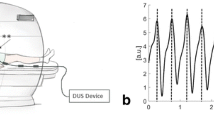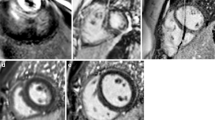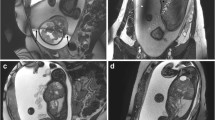Abstract
Background
Fetal cardiac magnetic resonance imaging (MRI) requires high spatial and temporal resolution and robustness to random fetal motion to capture the dynamics of the beating fetal heart. Slice-to-volume reconstruction techniques can produce high-resolution isotropic images while compensating for random fetal motion.
Objective
The objective of this study was to evaluate image quality for slice-to-volume reconstruction of four-dimensional balanced steady-state free precession (bSSFP) imaging of the fetal heart.
Materials and methods
A cohort of 13 women carrying fetuses with congenital heart disease were imaged with real-time bSSFP sequences. Real-time bSSFP sequences were post-processed using a slice-to-volume reconstruction algorithm to produce retrospectively gated 4-D sequences with isotropic spatial resolution. Two radiologists evaluated slice-to-volume reconstruction image quality on a scale from 0 to 4 using 11 categories based on a segmental approach to defining cardiac anatomy and pathology. A score of 0 corresponded to cardiac structures not visualized at all and four corresponded to high quality and distinct appearance of structures.
Results
In 11 out of 13 cases, the average radiologist score of image quality across all categories was 3.0 or greater. In the remaining two cases, slice-to-volume reconstruction was not possible due to insufficient image quality in the acquisition.
Conclusion
Slice-to-volume reconstruction has the potential to produce isotropic images with high spatial and temporal resolution that can display the anatomy of the fetal heart in arbitrary imaging planes retrospectively. More rapid, motion-robust acquisitions may be necessary to successfully reconstruct the fetal heart in all patients.





Similar content being viewed by others
References
Hoffman JI, Kaplan S (2002) The incidence of congenital heart disease. J Am Coll Cardiol 39:1890–1900
Bonnet D, Coltri A, Butera G et al (1999) Detection of transposition of the great arteries in fetuses reduces neonatal morbidity and mortality. Circulation 99:916–918
Calderon J, Angeard N, Moutier S et al (2012) Impact of prenatal diagnosis on neurocognitive outcomes in children with transposition of the great arteries. J Pediatr 161:94–98.e1
Eckersley L, Sadler L, Parry E et al (2016) Timing of diagnosis affects mortality in critical congenital heart disease. Arch Dis Child 101:516–520
Rajiah P, Mak C, Dubinksy TJ, Dighe M (2011) Ultrasound of fetal cardiac anomalies. AJR Am J Roentgenol 197:W747–W760
Pike JI, Krishnan A, Donofrio MT (2014) Early fetal echocardiography: congenital heart disease detection and diagnostic accuracy in the hands of an experienced fetal cardiology program. Prenat Diagn 34:790–796
Donofrio MT, Moon-Grady AJ, Hornberger LK et al (2014) Diagnosis and treatment of fetal cardiac disease: a scientific statement from the American Heart Association. Circulation 129:2183–2242
Marini D, Xu J, Sun L et al (2020) Current and future role of fetal cardiovascular MRI in the setting of fetal cardiac interventions. Prenat Diagn 40:71–83
Lloyd DFA, van Poppel MPM, Pushparajah K et al (2021) Analysis of three-dimensional arch anatomy, vascular flow and postnatal outcome in cases of suspected coarctation of the aorta using fetal cardiac MRI. Circ Cardiovasc Imaging 14:e012411
Firpo C, Hoffman JI, Silverman NH (2001) Evaluation of fetal heart dimensions from 12 weeks to term. Am J Cardiol 87:594–600
Wheeler T, Murrills A (1978) Patterns of fetal heart rate during normal pregnancy. Br J Gynaecol 85:18–27
Haris K, Hedström E, Kording F et al (2020) Free-breathing fetal cardiac MRI with doppler ultrasound gating, compressed sensing, and motion compensation. J Magn Reson Imaging 51:260–272
Roberts TA, van Amerom JFP, Uus A et al (2020) Fetal whole heart blood flow imaging using 4D cine MRI. Nat Commun 11:4992
Dong S-Z, Zhu M, Ji H et al (2020) Fetal cardiac MRI: a single center experience over 14-years on the potential utility as an adjunct to fetal technically inadequate echocardiography. Sci Rep 10:12373
van Amerom JFP, Lloyd DFA, Deprez M et al (2019) Fetal whole-heart 4D imaging using motion-corrected multi-planar real-time MRI. Magn Reson Med 82:1055–1072
Lloyd DFA, Pushparajah K, Simpson JM et al (2019) Three-dimensional visualisation of the fetal heart using prenatal MRI with motion-corrected slice-volume registration: a prospective, single-Centre cohort study. Lancet 393:1619–1627
Kording F, Yamamura J, de Sousa MT et al (2018) Dynamic fetal cardiovascular magnetic resonance imaging using Doppler ultrasound gating. J Cardiovasc Magn Reson 20:17
Roy CW, van Amerom JFP, Marini D et al (2019) Fetal cardiac MRI: a review of technical advancements. Top Magn Reson Imaging 28:235–244
Chaptinel J, Yerly J, Mivelaz Y et al (2017) Fetal cardiac cine magnetic resonance imaging in utero. Sci Rep 7:15540
Roy CW, Seed M, Kingdom JC, Macgowan CK (2017) Motion compensated cine CMR of the fetal heart using radial undersampling and compressed sensing. J Cardiovasc Magn Reson 19:29
van Amerom JFP, Lloyd DFA, Price AN et al (2018) Fetal cardiac cine imaging using highly accelerated dynamic MRI with retrospective motion correction and outlier rejection. Magn Reson Med 79:327–338
Roy CW, Seed M, Van Amerom JFP et al (2013) Dynamic imaging of the fetal heart using metric optimized gating. Magn Reson Med 70:1598–1607
Jansz MS, Seed M, van Amerom JFP et al (2010) Metric optimized gating for fetal cardiac MRI. Magn Reson Med 64:1304–1314
Haris K, Hedström E, Bidhult S et al (2017) Self-gated fetal cardiac MRI with tiny golden angle iGRASP: a feasibility study. J Magn Reson Imaging 46:207–217
Kording F, Schoennagel BP, de Sousa MT et al (2018) Evaluation of a portable doppler ultrasound gating device for fetal cardiac MR imaging: initial results at 1.5 T and 3T. Magn Reson Med Sci 17:308–317
Tsao J, Kozerke S, Boesiger P, Pruessmann KP (2005) Optimizing spatiotemporal sampling for k-t BLAST and k-t SENSE: application to high-resolution real-time cardiac steady-state free precession. Magn Reson Med 53:1372–1382
Yushkevich PA, Piven J, Hazlett HC et al (2006) User-guided 3D active contour segmentation of anatomical structures: significantly improved efficiency and reliability. Neuroimage 31:1116–1128
Yoo SJ, Lee YH, Cho KS, Kim DY (1999) Sequential segmental approach to fetal congenital heart disease. Cardiol Young 9:430–444
Carvalho JS, Ho SY, Shinebourne EA (2005) Sequential segmental analysis in complex fetal cardiac abnormalities: a logical approach to diagnosis. Ultrasound Obstet Gynecol 26:105–111
R Core Team (2013) R: a language and environment for statistical computing. R Foundation for Statistical Computing
De Wilde JP, Rivers AW, Price DL (2005) A review of the current use of magnetic resonance imaging in pregnancy and safety implications for the fetus. Prog Biophys Mol Biol 87:335–353
Tsao J, Boesiger P, Pruessmann KP (2003) K-t BLAST and k-t SENSE: dynamic MRI with high frame rate exploiting spatiotemporal correlations. Magn Reson Med 50:1031–1042
Otazo R, Candes E, Sodickson DK (2015) Low-rank plus sparse matrix decomposition for accelerated dynamic MRI with separation of background and dynamic components. Magn Reson Med 73:1125–1136
Feng L, Grimm R, Block KT et al (2014) Golden-angle radial sparse parallel MRI: combination of compressed sensing, parallel imaging, and golden-angle radial sampling for fast and flexible dynamic volumetric MRI. Magn Reson Med 72:707–717
Schloegl M, Holler M, Schwarzl A et al (2017) Infimal convolution of total generalized variation functionals for dynamic MRI. Magn Reson Med 78:142–155
Aviles-Rivero AI, Debroux N, Williams G et al (2021) Compressed sensing plus motion (CS+ M): a new perspective for improving undersampled MR image reconstruction. Med Image Anal 68:101933
Acknowledgments
This study was performed in line with the principles of the Declaration of Helsinki. Approval was granted by the Ethics Committee of Phoenix Children’s Hospital.
Author information
Authors and Affiliations
Corresponding author
Ethics declarations
Conflict of interest
None
Additional information
Publisher’s note
Springer Nature remains neutral with regard to jurisdictional claims in published maps and institutional affiliations.
Supplementary Information
Sagittal 2-D real-time acquisitions for subject 6 at 29 weeks’ gestational age. Minimal motion occurs during the acquisition. (MP4 867 kb)
Sagittal 2-D real-time acquisition for subject 5 at 25 weeks’ gestational age. Large fetal movement results in artifacts within individual frames. (MP4 1156 kb)
Multiplanar reformat simultaneously shows left-to-right: short-axis, four-chamber and 2-chamber views for subject 7 at 36 weeks’ gestational age. (MP4 525 kb)
Multiplanar reformat simultaneously shows three-vessel and trachea and other orthogonal views for subject 7 at 36 weeks’ gestational age. (MP4 422 kb)
A rendering of thresholded segmentation of blood pool for four-dimensional segmentation is oriented to demonstrate the aortic arch for subject 7 at 36 weeks’ gestational age. (MP4 2245 kb)
A rendering of thresholded segmentation of blood pool four-dimensional segmentation is oriented to demonstrate the left superior vena cava to coronary sinus for subject 7 at 36 weeks’ gestational age. (MP4 704 kb)
A 4-D multiplanar display of the heart at 34 weeks in a fetus with tetralogy of Fallot and pulmonary atresia. Subject 11 at 34 weeks’ gestational age. Left panel: coronal reformat. Middle panel: axial reformat. Right panel: sagittal reformat. (MP4 6588 kb)
A 4-D rendered view of threshold-based segmentation of the blood pool for the heart at 34 weeks in a fetus with tetralogy of Fallot and pulmonary atresia, frontal projection. Subject 11 at 34 weeks’ gestational age. (MP4 7615 kb)
A four-chamber view in subject 12 at 30 weeks’ gestational age. (MP4 291 kb)
A left ventricular outflow tract view of subject 12 at 30 weeks’ gestational age. (MP4 268 kb)
A three-vessel view of subject 12 at 30 weeks’ gestational age. (MP4 307 kb)
Rights and permissions
Springer Nature or its licensor holds exclusive rights to this article under a publishing agreement with the author(s) or other rightsholder(s); author self-archiving of the accepted manuscript version of this article is solely governed by the terms of such publishing agreement and applicable law.
About this article
Cite this article
Rubert, N.C., Jategaonkar, G., Plasencia, J.D. et al. Four-dimensional fetal cardiac imaging in a cohort of fetuses with suspected congenital heart disease. Pediatr Radiol 53, 198–209 (2023). https://doi.org/10.1007/s00247-022-05500-w
Received:
Revised:
Accepted:
Published:
Issue Date:
DOI: https://doi.org/10.1007/s00247-022-05500-w




